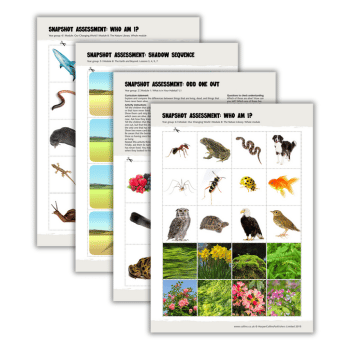This Snap Science assessment resource from Collins provides a number of activities for children to assess their scientific knowledge.
There are ‘odd one out’ questions, sequencing tasks and more, all with fantastic colour photography.
Year 2 (dead, living & non-living)
Tell the children that you are going to talk to them about things that are alive, were once alive or that have never lived.
Show them card strip three (included) and ask them to name the objects, helping where necessary. Ask which ones are alive. Which is the odd one out because it used to be alive but is not alive now? Ask how they know that it was once alive and how they know it isn’t alive now.
Tell the children that they are going to look at some more strips of pictures that have an odd one out, but that this might be the only one that is alive, the only one that used to be alive, or the only one that has never been alive.
Show two more card strips in turn and check that the children know what each picture shows. Be aware that the berries are particularly challenging for children because they might perceive these as having once lived but not be aware that they contain seeds so should be classed as living.
Repeat this activity three times to ensure they are secure with this. Finally, ask them to name another living thing, another that has once lived and another that has never lived.
Year 3 (light and dark)
Lay the included cards out on a table and ask children to consider each object in turn and to decide whether or not it helps them to see.
Ask children to describe each object carefully – i.e. a candle with a flame, an open eye – and to explain how it enables them to see (light sources give out light, eyes take light in).
From the group of objects that enable them to see, ask children to make a separate group containing the things that make their own light (sun, torch, TV, table lamp, candle with flame, stars).
Establish that we call these light sources. Put all the cards back together and ask the children to sort them into two piles: things that make their own light and enable us to see (the light sources), and things that may help us to see better (glasses, window, mirrors, carrots). Can they explain why?
Remove all the light sources, leaving just the open eye. Ask children what they would be able to see if there were no light sources. What do we call it when there is no light?
Year 4 (changes of state)
Show the children the included images. If necessary, clarify what they show without using the words for the state of matter or the change of state.
Give the change of state cards to the children and tell them to match the cards and pictures (some cards match with more than one picture).
Choose a picture and ask: What is the name of the change of state happening here? How can you tell that it is happening? What material is changing? Can you give me a sentence that describes this change of state? Is the change taking place at a cold, warm or hot temperature?
Give children the images of the ice cube, butter, chocolate and glass. Ask: Which one melts at the lowest temperature? Which needs the highest temperature to melt? Can you put them in order of melting temperature?
Year 5 (day and night)
Mix up and place on the table the included cards showing the shadow of a tree at different times of day. Tell the children to sequence the cards from early morning to dusk, and to annotate each one to show the position of the sun and the time of day.
Ask the children to describe the changes to the shape and position of the shadow and to explain why it changes. They should refer to the Sun’s apparent movement across the sky caused by the Earth’s rotation.
Year 6 (classification)
Place the included cards face up on the table in front of the children. Tell them to begin by sorting the cards into large groups, based on observable characteristics of the animals and plants included.
Children should arrive at an initial sort relatively easily; first of all dividing cards into those showing plants and animals, then sub-dividing animals into vertebrates and invertebrates.
Next, ask the children to reorganise the cards once again into sub-groups according to animal / plant observable characteristics. Where necessary, prompt children’s thinking by asking them questions.
When they have subdivided the cards as far as possible, check whether the children are able to name any of the groups they have created.
Provide them with a classification chart, so that they can check their groupings and remind themselves of sub-group names.
Snap Science is designed to help schools deliver outstanding, hands-on science lessons from the Early Years Foundation Stage to Key Stage 2.














